Are you thinking about the best attractions in Krakow on your first trip? Or maybe you’re returning for another round and this time, you’re on the hunt for those out-of-the-way tourist spots? Wondering how many days you’ll need to truly experience the city and where you can fill up on tasty food in between your monument-hopping adventures?

Well, you’re in the right place. When it comes to Krakow, I’m not just your average tourist. I live an hour’s drive from Kraków, so while I’m not exactly a local, but I’ve got a solid grasp of Krakow, like it’s an extension of our very own home. Yet, at the same time, I am continually uncovering its secrets with unabated curiosity.
- Looking for attractions for free? Check this out: Are There Any Free Things To Do in Krakow? Absolutely!
From my lowdown on Krakow’s allure, here’s what you’re going to learn:
- The celebrated spots that, I think, every visitor should make a point of checking out when in Krakow. This is your essential list of historical and cultural locales every explorer must tick off.
- The city’s leser-known charms that are often bypassed in the common tourist guides.
- The must-see places around Krakow. I’ve suggested some awesome locales close to the city, perfect for day trips.
- The yummiest eateries in the city. Because, I am convinced, no one should sightsee on an empty stomach. So, I’ve rounded up a bunch of recommendations on where to get a good meal, a satisfying cup of coffee, or a fine glass of wine.
My Best Krakow Attractions
Much like any traveler hitting Krakow, my fascination started with the charm of the Old Town and the Main Market Square, gradually reaching out to the city’s other streets and districts.
↳ Make sure to read my guide to the most amazing places to stay in Kraków:
How to Find Best Place to Stay in Krakow Old Town – Your Guide
When we first stumbled upon Kazimierz, it was a real eye-opener, even though the locals asserted that it had lost its vibe from the „good old days”. Regardless of such chatter, we found loads of charm in Kazimierz. We visit regularly because there’s no shortage of historical treasures and monuments here. Not to mention, the traditional food! In Kazimierz, we get to feast on everything from fancy meals at several gourmet spots to grab-and-go bites from the local food trucks.
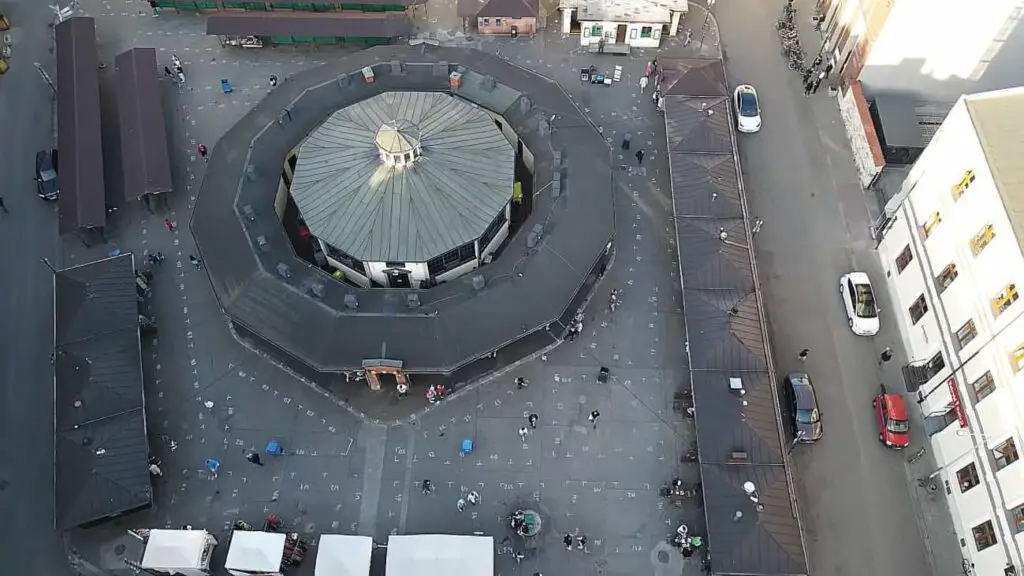
One day, we took our first step across the Vistula via the Bernatka Footbridge and discovered Podgórze. At first glance, it didn’t impress us much. But in recent years, I can tell you, we’ve witnessed the transformation of its sleepy waterfront streets into vibrant social hubs. Fancy restaurants serving exotic dishes and cosy cafes with mouth-watering pastries and aromatic coffee have moved in, adding to its appeal.
- For more information about Kraków districts, check this article: Krakow’s Districts – Where To Stay For A Visit or Live?
Krakow And its Hidden Corners
During our exploration, I uncovered the breathtaking sunsets atop Krakus Mound, the quaint St. Benedict church tucked away in the shadow of the imposing Fort Benedykt, and abandoned locomotives in Płaszów. We also delved into the tragic World War II history, which etched its indelible mark on this district.
And right before our eyes, the once dusty and industrial Zabłocie, a part of Podgórze, bloomed into one of the city’s most hip districts, drawing us in with its unique attractions. In a nutshell, we found ourselves completely captivated by this intriguing district – especially my girlfriend, who dived headlong into its rich history.
We also ventured into other areas like Nowa Huta and Dębinki. Our curiosity for Krakow, its history and allure, remains alive and kicking to this day, and we’re far from convinced that we’ve uncovered all of its hidden gems.

Initially, I thought writing about the Market Square, Wawel Castle, and the mounds of Nowa Huta was, well, a bit too mainstream. As a result, out of several hundred blog posts, only a handful are about Krakow, mostly focusing on cool cafes, breakfast spots, and bike routes. There was a definite dearth of information about the city’s monuments, attractions, and fascinating places. But I decided it was time to change that.
I know that Krakow’s charm could fill up entire books, and if I included its nearby areas, I am talking about some hefty travel guides here. So, in the following section, I am focusing on listing and providing a brief overview of Krakow’s key attractions. I plan to delve deeper into these topics in future posts, touching on Krakow’s museums, churches, viewpoints, and the formidable Krakow Fortress.
The Must-Visit Spots in Krakow
So here is the complete list of most interesting places to visit in Kraków.
The Old Town – Vibrant Place
Let’s not beat around the bush – when it comes to Krakow’s top places to visit, the Old Town is the undisputed winner. This historic and most renowned part of the city was crowned a UNESCO World Heritage Site in 1978, earning a prime spot on the list. The tourist hub of Krakow is teeming with life pretty much 24/7, with each season bringing its own distinct vibe.
Brimming with tourists in the summer, the Old Town is a hub of activity with life focused around the open-air cafes and restaurants lining the Main Market Square and the streets shooting off from it. Come winter, the buzz quiets down, and the ancient cellars of Krakow, bearing memories of historical figures like Jan Długosz and Wit Stwosz, grow in popularity.

Our journey exploring Krakow began with strolls around the Market Square, and we believe it’s the perfect starting point for your Krakow adventure.
Main Market Square – Heart of The City of Kraków
If the Old Town is considered the hub of Krakow, then the Main Market Square is undeniably its beating heart. Holding the title of Poland’s largest and one of Europe’s most picturesque squares, it’s a melting pot of local and foreign tourists.
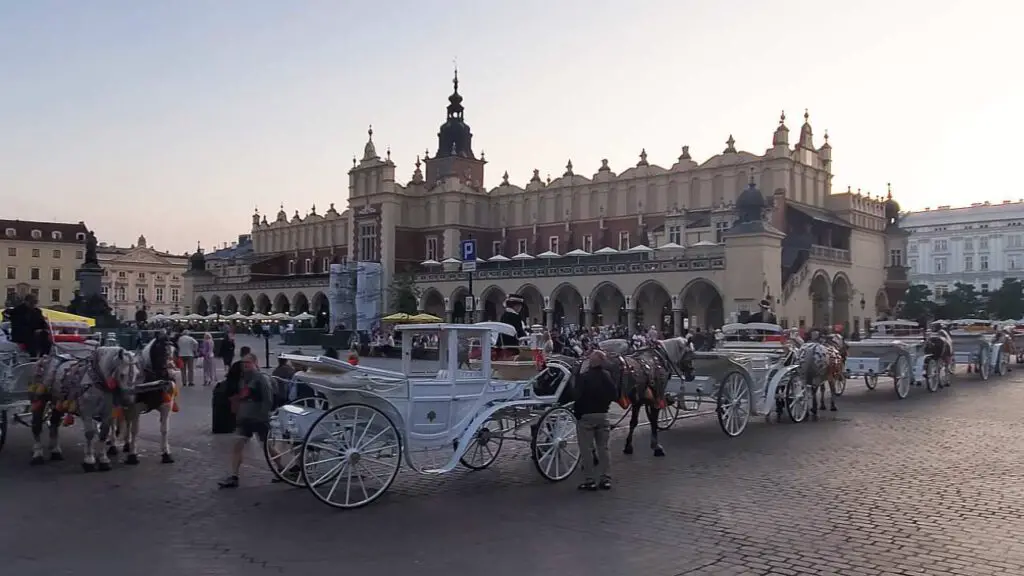
The chatter of various languages weaves through the melodies of street musicians, the clop-clop of horse-drawn carriages, and the hourly bugle call. Add to the mix, street performers, kids chasing soap bubbles, and a flurry of pigeons. It can feel a bit too lively for some, but for others, it’s a haven of vibrancy. And if you need a bit of peace, just step into a side street to escape the hubbub.
Surrounding the square are the ornate facades of historic tenement houses, each with its own captivating tale to tell. The square itself is home to some of Poland’s most iconic monuments. We’ll soon invite you to a detailed walk around the Main Market Square, so stay tuned!
Adam Mickiewicz’s Statue
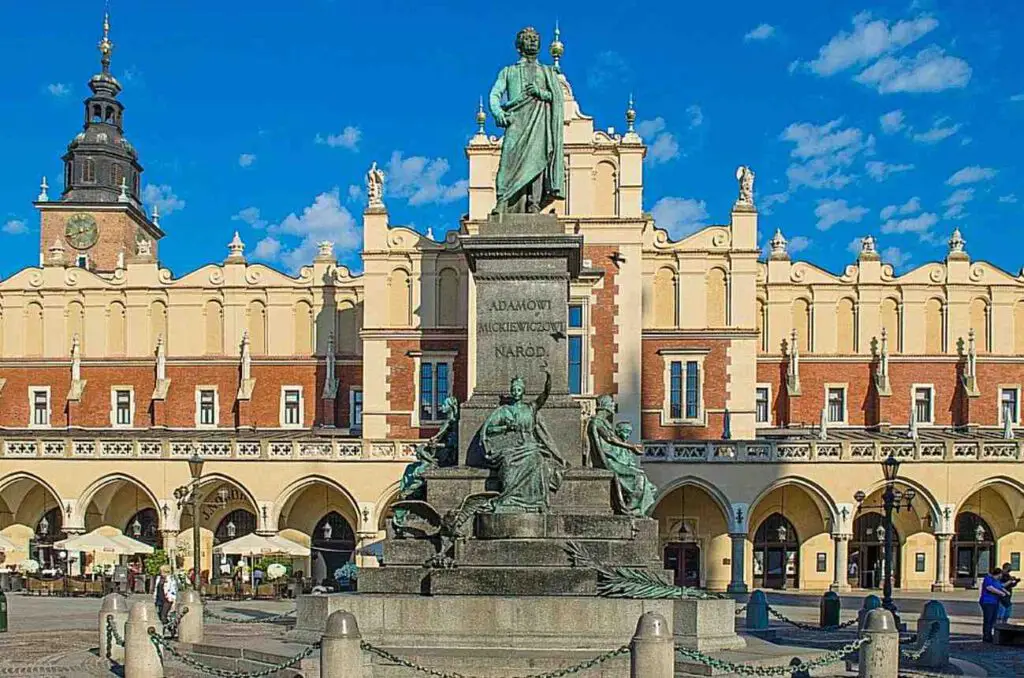
Let’s kickstart our tour at the statue of Adam Mickiewicz, national bard. Mickiewicz’s silhouette is among the city’s most recognized landmarks, and it’s common for locals to rendezvous „under Adam” (pigeons seem to love perching on him too!).
The statue has been a silent spectator of history since the late 19th century but has also been its victim. The statue, accompanied by figures symbolizing the Nation, Science, Poetry, and Patriotism, was deemed too Polish by the Germans, leading to its destruction in 1940. The statue that stands in the Market Square today is a reconstruction, incorporating original pieces discovered in places like Hamburg.
St. Mary’s Church – A Masterpiece of Sacral Art

When talking about Krakow’s most famed church, St. Mary’s Basilica, it’s impossible not to mention its grand interior housing a gem of medieval religious art – the Wit Stwosz altar. In early 2021, the altar underwent one of the most significant restorations in its long history.
This architectural marvel’s ceiling was adorned by some of the greatest Polish painters like Jan Matejko, Józef Mehoffer, and Stanisław Wyspiański, all key figures in Krakow’s history.
- You may also be interested in reading: Art in Kraków – A List Of 15 Most Famous Paintings
From its tower, aptly named „Hejnalica„, a bugle call echoes every hour on the hour. And for those not troubled by vertigo, the tower is open for a tour up its steep steps. This church, with its rich interiors, merits its own narrative – we often pop in casually and always stumble upon something I hadn’t spotted during my previous visit.
Cloth Hall in Kraków – A Medieval Shopping Mall
Picture this, the Cloth Hall, or „Sukiennice” as it’s called, was esentially a shopping mall built by Casimir the Great. The name „Sukiennice” which means „dresses” hails from the cloth trade, largely sourced from Germany and Flanders, that took place within its walls.

Nowadays, the building radiates elegance, but imagine this – till the late 19th century, makeshift wooden stalls huddled alongside it, selling everything from food to livestock. Imagine the blend of aromas, dust, dirt, and remnants of goods strewn all around the market – makes you appreciate the amber stalls a bit more, doesn’t it?
The upper floor houses the 19th Century Polish Art Gallery, boasting pieces like the renowned „Prussian Homage” by Jan Matejko. Close by, you’ll find the Szał café, which treats you to one of the best views of the Market Square and St. Mary’s Church from its terrace.
Town Hall Tower – Bird’s Eye View

If you’re on the hunt for a town hall in the Market Square, like the ones you might’ve seen in Wrocław, Poznań, Lublin, or nearby Tarnów, I’m afraid we’ll have to disappoint you. Krakow used to have a town hall situated within the Main Market Square, but a poorly executed renovation led to its demolition in 1820. The 70-meter high Town Hall Tower is all that remains, currently hosting a branch of the Museum of the City of Krakow. For many, the true highlight is the opportunity to climb to its summit and view the Market Square from a pigeon’s eye view. 😉
Church of St. Wojciech

The diminutive church nestled within the Krakow market is among the city’s most ancient, supposedly built on the spot where, as per legend, Prague Bishop Wojciech celebrated Mass before setting off to Prussia.
Indeed, archaeological excavations have unveiled foundations dating back to the turn of the 10th and 11th centuries. The existing church, constructed in the 11th century in Romanesque style, was revamped in the Baroque style in the 17th century.
There’s often chatter that it’s Krakow’s smallest church, but the Church of St. Benedict in Podgórze appears to be a tad more compact.
The Streets and Hidden Gems of the Old Town
While the Main Market Square is the most bustling, and houses some of Krakow’s critical monuments, the streets of the Old Town ooze their unique aura and conceal numerous cherished corners.
The Collegium Maius, the Szołayski House with an exhibit on Szymborska, Zaułek Niewiernego Tomasza, the Archdiocese Museum, and Archaeological Museum are all worth a visit. Moreover, there’s no shortage of dining options, with countless pubs, bars, and cafés tucked away in the side streets, catering to diverse palates and budgets.
- Please read about greatest museum is Kraków: Top 13 Must-See Museums in Krakow – You Private Guide
Barbican, St. Florian’s Gate, and Remnants of the City Walls with Towers
It’s quite astonishing that owing to the single-handed resolve of Feliks Radwański, a 19th-century architect and professor at the Jagiellonian University, we’re able to marvel at renowned structures like the Barbican and St. Florian’s Gate, along with the remnants of the city walls and three towers.
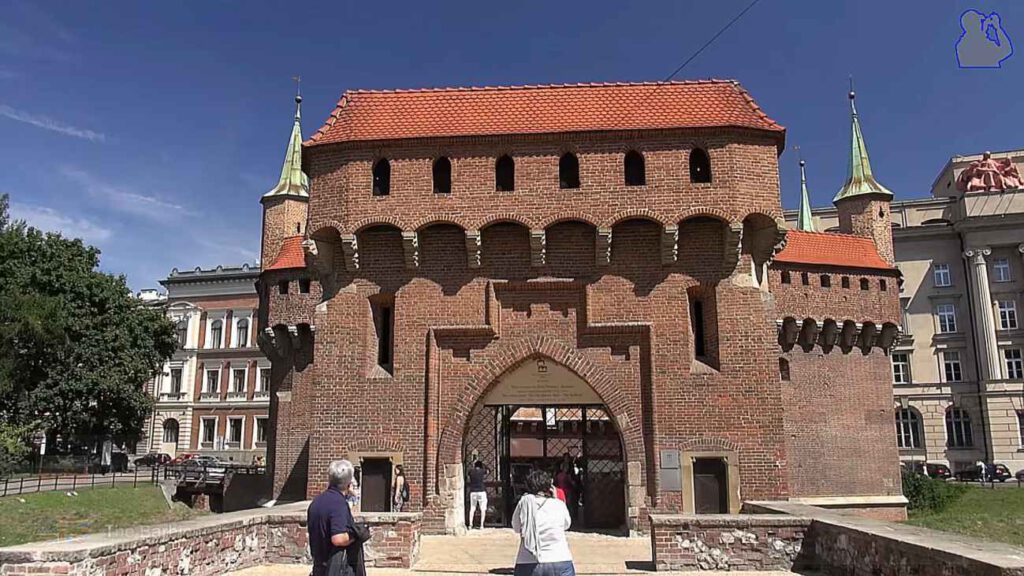
Today, it’s almost impossible to picture Krakow’s landscape sans these buildings. Still, if it hadn’t been for Radwański’s tenacity, we would likely see flowerbeds and sidewalks there, much like the fate of other city walls torn down in the 19th century.
Thanks to his efforts, a section of the once double city walls, studded with dozens of towers and gates, survives. The preserved fragments of Krakow’s defense system are now a part of the „Defensive Walls” section of the Museum of the City of Krakow. Hunt for traces of the vanished city walls (reinforced with 39 towers, 8 gates, and circled by a moat) in the Planty – keep your eyes peeled and look under your feet!
Krakow Planty – Green Halo of the Old Town
No stroll through Krakow is complete without a leisurely amble through Planty, the city’s oldest park, which came into existence on the land formerly occupied by city walls. With the demolition of the walls, the area was innovatively transformed into a public park – a novel concept in those times.
This lush ring enveloping the Old Town was formed in the 19th century under the guidance of Florian Straszewski, whose contribution is commemorated by a street named in his honor, adjacent to Planty from the Wawel Castle side.
- Speaking of Wawel, please check this article about the legendary dragon: Unraveling the Tale of The Wawel Dragon – Krakow’s Emblem
With a perimeter of around 4 kilometers, Planty offers a substantial walk, during which you can admire a variety of sights. These include the neo-Gothic seminary where Karol Wojtyła studied, the Archaeological Museum with its „secret” garden, the Carmelite monastery, and numerous statues honoring eminent scientists, royal couples, and artists. There are also two beautifully designed playgrounds, one near the Archaeological Museum and the other off ul. St. Gertrude.
As you saunter along Planty, the remnants of the city’s old fortification system become apparent. Commemorative plaques mark the locations of former towers, each bearing the names of the guilds responsible for their upkeep. Furthermore, a half-meter-high wall has been erected in many places, illustrating the former course of the city walls.
Wawel Hill
Overlooking the Old Town is Wawel, a limestone hill that has observed the ebbs and flows of the Polish state for a millennium. Its peak is crowned with the Royal Castle and the Cathedral Basilica of St. Stanislaus and St. Wenceslas, colloquially known as Wawel Cathedral.
These iconic landmarks have become inseparable from the city’s landscape. In spring, visitors flock here to celebrate the season, with blooming magnolias signaling its arrival. Summer nights, on the other hand, fill the castle courtyard with music as part of the „Wawel at Dusk” festival.
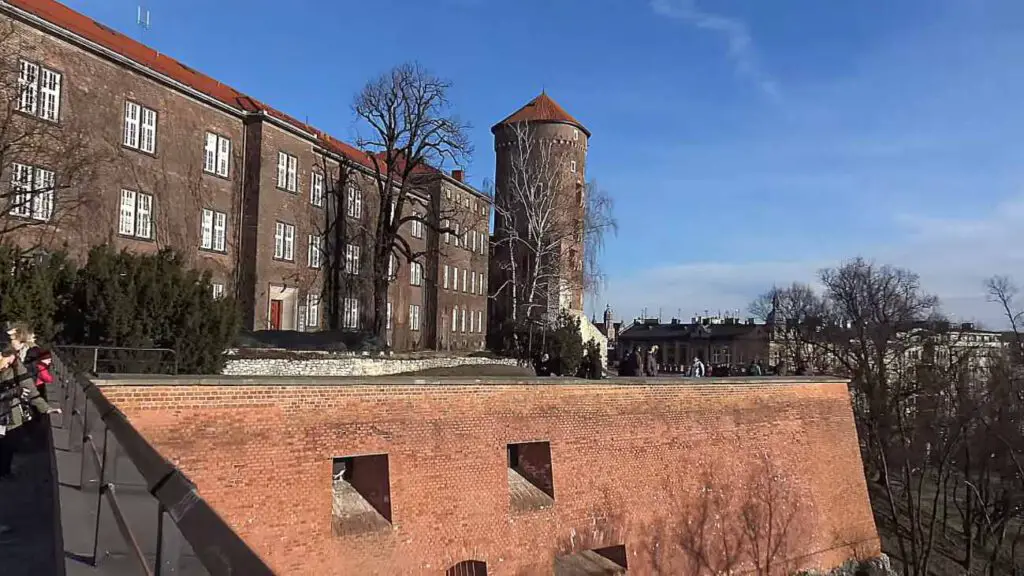
No matter the season, it’s worthwhile to pause here during a Krakow sojourn, perhaps to admire the view of the Vistula River from the observation deck or take a shaded stroll amidst historical buildings. For a stunning panorama of Wawel, we recommend heading across the Vistula River, perhaps to the summer garden of Cafe Manggha.
Detailing this national treasure is beyond our capacity – it simply must be experienced in person. The easiest route to reach Wawel is via ul. Grodzka, along a wall adorned with „Wawel bricks„. These bricks serve as a reminder of the time when the Austrians handed over Wawel, which had been used as military barracks, back to the Poles. The extensive renovation that ensued led to fascinating historical and archaeological explorations. But that, as they say, is a story for another time…
Kazimierz District – A Melding of Cultures
Kazimierz, established in the 14th century by King Casimir the Great, initially functioned as an independent city. Over time, owing to laws permitting Jewish settlement, it evolved into a crucial urban center for this minority in Poland.

At the cusp of the 18th and 19th centuries, a decision to incorporate Kazimierz into Krakow as a new district was made. However, the development of Kazimierz came to an abrupt halt due to the horrendous events of World War II. Germans displaced the Polish population eastward and forced the Jews into the Podgórze ghetto, from where they were later sent to death camps. This grim period marked a tragic conclusion to the centuries-old, multicultural tradition of Kazimierz, Krakow, and Poland.
- Read more and check pictures showing the Ghetto here: Krakow Ghetto – A Journey Through the Shadows of World War II
For years, despite its proximity to the Old Town, this district remained somewhat forgotten and overlooked. Today, it has reemerged as one of the main attractions of Krakow, where the Jewish heritage (among others) is rediscovered. Visitors will find an array of valuable monuments and a collection of commendable restaurants, cafes, food trucks, and pubs waiting to be explored.
Church on the Rock
The Church on the Rock is the colloquial name for the Basilica of St. Michael the Archangel and St. Stanislaus Bishop and Martyr. This significant Krakow temple is deeply intertwined with the history of Poland from its inception and the cult of Krakow’s bishop, Stanisław, who was sentenced to death for treason by the Polish king, Bolesław the Generous.

This resulted in a grim end for the king, while the supposed traitor was canonized as a saint and patron of the country. This fascinating tale of historical twists and turns would warrant a separate dissertation.
In the subsequent centuries, the church transformed into a national pantheon, becoming the final resting place of many illustrious Poles, including Karol Szymanowski, Stanisław Wyspiański, and Czesław Miłosz.
A visit in springtime is particularly recommended – the Vistula boulevards in front of the church are blanketed with vibrant crocuses.
The Old and New Jewish Cemeteries
The Old Jewish Cemetery, also referred to as the Remuh (or Remu) Cemetery, derives its name from a renowned 16th-century rabbi and philosopher interred here. As the oldest Jewish cemetery in Krakow and the third oldest in Poland, following Wrocław and Lublin, it offers a significant historical experience. Both the necropolis and the adjacent synagogue are open to visitors.

The New Jewish Cemetery, located on the fringes of Kazimierz, on Miodowa Street, is the final resting place of many distinguished city figures, including Maurycy Gottlieb, a talented student of Jan Matejko. As an active cemetery, it’s important to remember that men should wear a hat when entering. This cemetery remarkably survived World War II in relatively good condition, a curious fact to which we would love to know the answer.
Synagogues – The Testaments of Time

Of the numerous synagogues and houses of prayer, only seven synagogues stand today, with only the Remuh Synagogue conducting regular services. The others can be visited occasionally. However, the majority of synagogues were devastated during the German occupation, some even being converted into apartments. As you stroll through the streets of Kazimierz, you might unknowingly pass by a former Jewish temple.
Interesting Places in Krakow’s Podgórze District
Across the Vistula from Kazimierz, you will find the evolving neighborhood of Podgórze – another striking district of Krakow. A little over a century ago, this was an independent, flourishing city.
In 1784, Podgórze was granted city rights by Austro-Hungarian Emperor Joseph II. The new city, built in the Austrian style, was intended to rival Polish Krakow. Over the following years, the city thrived economically, so that when Podgórze and Krakow merged in 1915, it was a union of equals.
Many contemporary observers even stated that wealthy Podgórze was marrying down with economically struggling, but culturally rich and traditional Krakow. If this history intrigues you, we invite you to delve deeper into our dedicated article on the fascinating past of Podgórze: „Krakowskie Podgórze – the History of Galician America”.
Father Bernatka Footbridge
Initiating our exploration of Podgórze, we start at the Bernatka Footbridge. For many, the adventure with Podgórze begins right here. Opinions on the aesthetic of the footbridge are mixed, but that doesn’t detract from the fact that it has already established itself as one of the city’s symbols and a crucial connection between two worlds.

The footbridge’s construction naturally extended the walk from Kazimierza Street and Mostowa to the other side of the river, radically transforming the character of both banks of the Vistula within a few years. This investment prompted the creation of numerous cafes, restaurants, and pubs in both Kazimierz and Podgórze districts.
We find it most enchanting when illuminated at night, its romantic ambiance evidenced by the countless love locks attached to its railings by smitten couples.
As an interesting aside, a promise to construct a new bridge between the two sides of the Vistula River was made at the beginning of the 20th century in the agreement uniting the two cities. However, several decades elapsed before it was finally built.
Podgorski Market

Undeniably the heart of Podgórze, the Podgorski Market is an architectural gem. The square is uniquely trapezoidal, with its shorter side slightly raised above the longer one. This design creates an optical illusion, making the soaring St. Joseph’s Church appear larger than it truly is.
Recently, the market square underwent an extensive renovation, transforming into a haven for relaxation and strolls. Panels around the square display its transformation over the years, allowing visitors to journey through time.
Church of St. Joseph
Dominating the Podgórze skyline, the Church of St. Joseph is arguably the district’s most impressive historical structure. Pay close attention to the church tower, which strikingly resembles the Hejnalica of St. Mary’s Church. The church was designed by Jan Sas Zubrzycki, who initially had Warsaw’s Plac Zbawiciela in mind for its location. However, the magnificent building ultimately found its home in Krakow.
Krakus Mound – A Sunset Haven
Were you to ask me my favorite viewpoint in Krakow, without hesitation, I would choose the Krakus Mound. From here, you can enjoy a breathtaking panorama of Podgórze, Kazimierz, and the majestic Wawel Hill.

Yet, the true magic unfolds at sunset, when the sun descends behind the Wolski Forest, casting a beautiful glow over the entire city. The ambiance around the mound is almost picnic-like, so come prepared with a blanket and snacks.
The Krakus Mound is one of the oldest surviving structures in Krakow. Estimated to have been built between the 6th and 8th centuries, its exact age is uncertain due to the discovery of artifacts from various historical periods inside it.

Among the four mounds in Krakow, we find this one the most intriguing. Apart from its scenic beauty and panoramic views of historic and modern Krakow, on clear days, it even offers a glimpse of the Tatra Mountains, about 90 kilometers away.
Fort Benedict – Unique European Relic
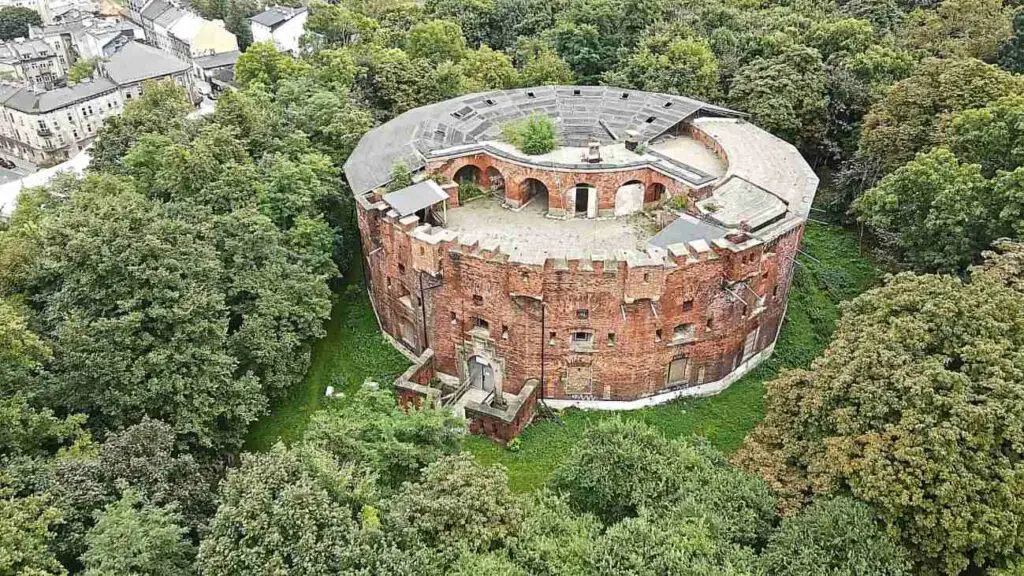
At first glance, you can tell that Fort Benedict is an extraordinary structure. Indeed, it is a singular artillery fort in Krakow and unique in Europe, constructed as part of the Krakow Fortress concept. Named after the nearby St. Benedict Church, this monument awaits a new purpose. Currently, visitors must admire its grandeur from outside its gate and fence.
Fort Benedict is one of several forts included in the Krakow Fortress. Interested? I invite you to explore other forts in Krakow that have been given a second life.
Church of St. Benedict
Perched on the edge of a hill, the Church of St. Benedict is Krakow’s smallest and dates back to the 10th-11th century. It is typically closed to visitors, opening its interiors only twice a year – on St. Benedict’s Day (March 21) and during the holiday of Sleeves, which falls on the first Tuesday after Easter.
Reportedly, thanks to the efforts of Podgórze enthusiasts, the church will soon be more frequently accessible. This is especially exciting given that recent archaeological excavations at this site have revealed new insights about the religious practices historically conducted here.
Oskar Schindler’s Enamel Factory

Schindler’s Factory, thanks to Steven Spielberg’s film „Schindler’s List”, has become a significant destination for tourists visiting Krakow from all over the world. However, the museum is not exclusively dedicated to the life and deeds of Oskar Schindler.
Instead, Schindler’s character serves as a backdrop for recounting life in Krakow during World War II, both within and beyond the Krakow ghetto. The poignant story is relayed in a contemporary and thought-provoking manner. In our view, Schindler’s Factory stands out as one of Poland’s finest museums and is a must-visit when in Krakow.
- Please check the other interesting museum in Kraków: Top 13 Must-See Museums in Krakow – You Private Guide
Ghetto Heroes Square
Prior to World War II, this square served as an unremarkable bus station connecting Krakow with neighboring towns. However, during the war, it bore witness to devastating events, as depicted in the book „Pharmacy in the Krakow Ghetto„.
From this square, Jewish residents were transported from the Krakow ghetto to extermination camps, while the staff of the eponymous pharmacy became a center of resistance against Nazi policies.
Today, a unique monument of rows of chairs stands to remember those who never returned home.
The Eagle Pharmacy

Throughout World War II, this historic building operated as the sole pharmacy within the Krakow ghetto. Now, within its walls at Plac Bohaterów Getta, stands a museum dedicated to the activities of the pharmacy and its employees who risked their lives to aid Jews living in the ghetto. For those interested, we recommend Tadeusz Pankiewicz’s book „Apteka w getcie krakowskim” („Pharmacy in the Krakow Ghetto”), the then-manager of the Pharmacy under the Eagle.
Bednarski Park
While Bednarski Park may not be one of Krakow’s largest parks, it is undoubtedly one of our favorite green havens in the city. Tucked away from the usual tourist paths, it provides a perfect respite during a stroll through Podgórze. Do remember to carry peanuts for the local squirrels, who, being accustomed to people, will gladly eat from your hand.
Interestingly, Bednarski Park was established on the site of a former limestone mine, lending it a varied landscape.

The innovative idea of transforming former industrial areas into a park was revolutionary at the time. The project owes much to Wojciech Bednarski, a Podgórze social worker who partly funded the transformation. His contribution continues to be honored in the name of the park today.
High limestone walls and pathways winding through small hills distinguish this park from others in the city. From the park’s southern slope, you can enjoy a panorama of Krakow, particularly breathtaking in autumn and winter when trees have shed their leaves and do not obstruct the view. The park’s proximity to St. Benedict’s Church, Fort Benedict, and the Krakus Mound makes it an ideal starting point for exploration.
The Many Faces of Krakow – From Socialist Realism to Natural Wonders
Let’s leave Podgórze district and move to another parts of the town.
Nowa Huta District
Emerging as a brand new city, Nowa Huta was conceived to blend modern urban ideals. A socialist „utopian city” and a garden city, all the while providing accommodation for the workforce of the newly established steelworks, one of the largest in Poland at the time.
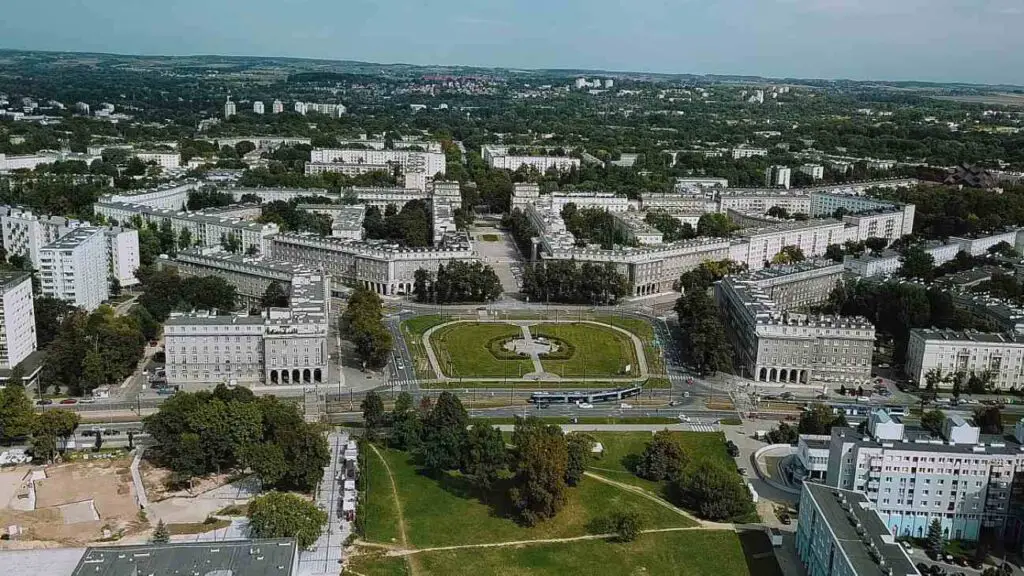
In terms of architectural value, the so-called „Stara Huta” with its Central Square and Aleja Róż Street, is particularly noteworthy. It’s crucial to remember that Nowa Huta was not built from scratch. It was established upon previously existing villages. As a result, in spite of the construction of new residential estates and industrial plants, the area still harbors vestiges of old manor houses, palaces, wooden churches, and forts of the Krakow Fortress.
For years, this easternmost and largest district was not considered a tourist attraction of Krakow. Following the collapse of the „rightly past system”, the original socialist-realist architecture was not seen as valuable. It is only in recent years that its historical, architectural, and educational values have begun to be recognized, leading to a growing influx of tourists.
While we prepare a special blog post dedicated to this part of Krakow, I invite you to explore cycling route around Nowa Huta and its key attractions.
The districts mentioned above tend to be the primary points of interest for most tourists. However, if you appreciate exploring beyond the beaten path and are interested in lesser-known Krakow spots, I can’t help but recommend my favorite locales outside the city center.
Zakrzówek Reservoir
If you’re seeking a truly unique natural and landscape attraction, something other Polish cities cannot offer, the Zakrzówek Reservoir is a must-visit. Although not a natural feature — it was formed in an abandoned limestone quarry — it quickly became a wild oasis amidst the urban sprawl.

With its extraordinary charm, the reservoir’s water sparkles turquoise on sunny days, creating a stunning contrast against the white limestone cliffs, all nestled within lush greenery. Zakrzówek is a favorite amongst Krakow’s resdents, offering a much-needed retreat from the summer heat with its guarded swimming areas.
Kosciuszko Mound

In search of another viewpoint? I invite you to the Kościuszko Mound. Erected in 1823 to honor the leader of the insurrection, it now serves as a convenient lookout point over Krakow and its surroundings. While there’s an admission fee to reach the mound’s summit, you can also admire the city panorama from the cafe located in the Kościuszko fort, both day and night.
Camaldolese Monastery in Bielany

Perched atop Srebrna Góra Hill, the church, along with the Camaldolese hermitage, majestically overlooks the Vistula valley. In our view, it is most strikingly admired from the bicycle route leading to the Monastery in Tyniec, though it can be seen from numerous locations in Krakow.
It’s worth noting that, due to the monastery’s rules, while men can visit year-round, women are only permitted to enter the monastery gates 12 times a year — so ensure your visit is well-planned.
Benedictine Monastery in Tyniec
Indeed, it’s still Krakow as Tyniec was annexed into the city in 1973. This almost thousand-year-old monastery, splendidly situated on the Vistula River, ranks among Krakow’s prime tourist attractions. The bicycle path tracing the river’s embankment is undeniably a favorite locale for the city’s residents to engage in active recreation, including ourselves. For more details, we welcome you to the blog post about the Monastery in Tyniec, where we share how effortlessly and delightfully you can reach it from the heart of Krakow, be it by bike or bus.
Activities in Krakow
If you yearn for a respite from marveling at historical structures and touring museums, or perhaps you feel a pang of guilt and the need to shed excess calories following intensive culinary indulgence in Krakow’s restaurants and cafes, we have a solution! I urge you to embark on an active exploration of Krakow.
Bicycles in Kraków

I navigate Krakow by bicycle as long as the weather permits. The city’s bicycle infrastructure is continually developing and despite occasional inconveniences, cycling in Krakow is, in our opinion, enjoyable, safe, and fun — at least on the routes we frequently traverse.
From the vicinity of the Market Square, it’s pleasant to ride along the Vistula boulevards, detour by Błonia, venture into Podgórze and Zabłocie, visit the Monastery in Tyniec, and even pedal up to Krakow’s very mounds. As you can see, Krakow’s attractions can be explored by bicycle.
The more ambitious can set off on extended cycling trips around Krakow, heading towards the Ojcowski National Park or the Krakow Valleys, which we discuss later in this blog post.
Kayaks in Kraków

With each passing season, we notice a growing recreational use of the Vistula. This not only includes ships ferrying tourists between Wawel and Tyniec but also an increasing number of kayaks and SUPs, i.e., boards that can be paddled while standing or kneeling. At the bend near Wawel, the Vistula flows languidly and isn’t technically challenging, thus even moderately experienced paddlers can navigate it with ease.
We, too, partook in such entertainment, renting kayaks near the Railway Water Club 1929 at the Zwierzyniecki Bridge (the cost of renting a double kayak for 2 hours is approx. PLN 50).
If you prefer a more intimate setting, you can try your hand at rafting on Dłubnia, a river that winds through Nowa Huta district and flows into the Vistula. Despite initial impressions, it is quite a wild river, ensconced in verdant surrounds.
Summary
So, this article was a comprehensive guide to exploring the captivating city of Krakow, focusing on both well-known and lesser-known attractions. Starting with the globally recognized Oskar Schindler’s Enamel Factory, it delves into the poignant historical sites of Ghetto Heroes Square, The Eagle Pharmacy, and Bednarski Park.
The narrative then travels to Nowa Huta, a district rich with socialist architecture, before revealing the natural allure of Zakrzówek Reservoir and the commanding viewpoint of the Kościuszko Mound.
- If you still haven’t decided for how long you should stay in Kraków, you better also read this: How Long or How Many Days Should You Stay in Kraków?
The guide also acquaints readers with the spiritual havens of the Camaldolese Monastery in Bielany and the Benedictine Monastery in Tyniec, offering glimpses into their historical and cultural significances. Lastly, it encourages active exploration of the city via bicycles and kayaks, adding an element of adventure to the sightseeing experience.
Overall, this thread presents a vibrant tableau of Krakow’s historical landmarks, architectural treasures, natural beauty, and recreational activities, promising an enriching and invigorating journey through the city’s heart and beyond.
Reference:
- https://e-krakow.pl/atrakcje
- https://www.morizon.pl/blog/28-rzeczy-za-darmo-w-krakowie/
- http://www.krakow.travel/




